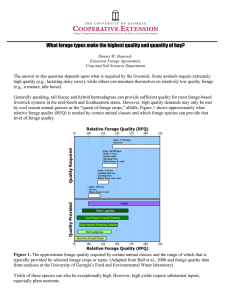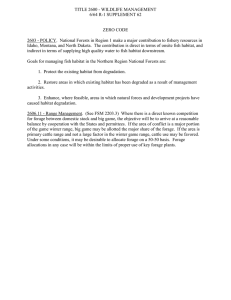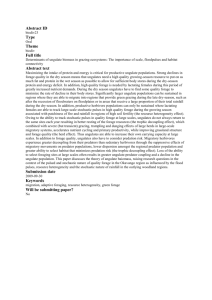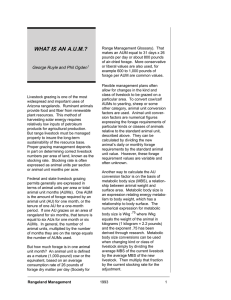Stocking Small Pastures Using AUM’s – Part 1
advertisement
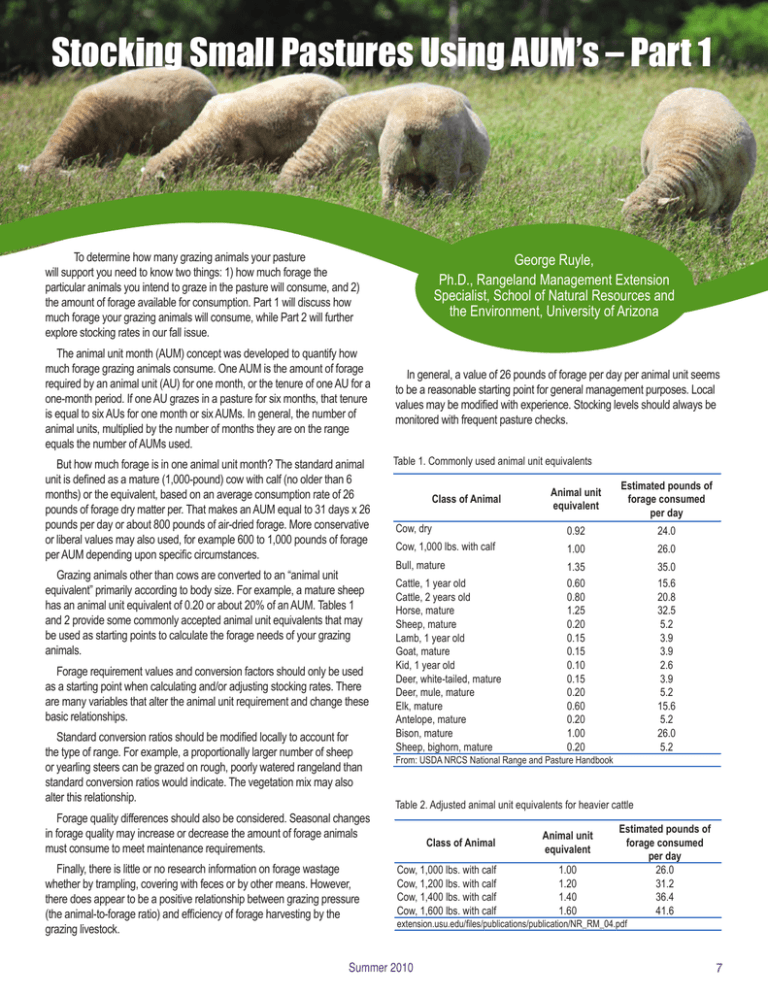
Stocking Small Pastures Using AUM’s – Part 1 To determine how many grazing animals your pasture will support you need to know two things: 1) how much forage the particular animals you intend to graze in the pasture will consume, and 2) the amount of forage available for consumption. Part 1 will discuss how much forage your grazing animals will consume, while Part 2 will further explore stocking rates in our fall issue. The animal unit month (AUM) concept was developed to quantify how much forage grazing animals consume. One AUM is the amount of forage required by an animal unit (AU) for one month, or the tenure of one AU for a one-month period. If one AU grazes in a pasture for six months, that tenure is equal to six AUs for one month or six AUMs. In general, the number of animal units, multiplied by the number of months they are on the range equals the number of AUMs used. But how much forage is in one animal unit month? The standard animal unit is defined as a mature (1,000-pound) cow with calf (no older than 6 months) or the equivalent, based on an average consumption rate of 26 pounds of forage dry matter per. That makes an AUM equal to 31 days x 26 pounds per day or about 800 pounds of air-dried forage. More conservative or liberal values may also used, for example 600 to 1,000 pounds of forage per AUM depending upon specific circumstances. Grazing animals other than cows are converted to an “animal unit equivalent” primarily according to body size. For example, a mature sheep has an animal unit equivalent of 0.20 or about 20% of an AUM. Tables 1 and 2 provide some commonly accepted animal unit equivalents that may be used as starting points to calculate the forage needs of your grazing animals. Forage requirement values and conversion factors should only be used as a starting point when calculating and/or adjusting stocking rates. There are many variables that alter the animal unit requirement and change these basic relationships. Standard conversion ratios should be modified locally to account for the type of range. For example, a proportionally larger number of sheep or yearling steers can be grazed on rough, poorly watered rangeland than standard conversion ratios would indicate. The vegetation mix may also alter this relationship. Forage quality differences should also be considered. Seasonal changes in forage quality may increase or decrease the amount of forage animals must consume to meet maintenance requirements. Finally, there is little or no research information on forage wastage whether by trampling, covering with feces or by other means. However, there does appear to be a positive relationship between grazing pressure (the animal-to-forage ratio) and efficiency of forage harvesting by the grazing livestock. George Ruyle, Ph.D., Rangeland Management Extension Specialist, School of Natural Resources and the Environment, University of Arizona In general, a value of 26 pounds of forage per day per animal unit seems to be a reasonable starting point for general management purposes. Local values may be modified with experience. Stocking levels should always be monitored with frequent pasture checks. Table 1. Commonly used animal unit equivalents Animal unit equivalent Estimated pounds of forage consumed per day Cow, dry 0.92 24.0 Cow, 1,000 lbs. with calf 1.00 26.0 Bull, mature 1.35 0.60 0.80 1.25 0.20 0.15 0.15 0.10 0.15 0.20 0.60 0.20 1.00 0.20 35.0 15.6 20.8 32.5 5.2 3.9 3.9 2.6 3.9 5.2 15.6 5.2 26.0 5.2 Class of Animal Cattle, 1 year old Cattle, 2 years old Horse, mature Sheep, mature Lamb, 1 year old Goat, mature Kid, 1 year old Deer, white-tailed, mature Deer, mule, mature Elk, mature Antelope, mature Bison, mature Sheep, bighorn, mature From: USDA NRCS National Range and Pasture Handbook Table 2. Adjusted animal unit equivalents for heavier cattle Class of Animal Cow, 1,000 lbs. with calf Cow, 1,200 lbs. with calf Cow, 1,400 lbs. with calf Cow, 1,600 lbs. with calf Animal unit equivalent 1.00 1.20 1.40 1.60 Estimated pounds of forage consumed per day 26.0 31.2 36.4 41.6 extension.usu.edu/files/publications/publication/NR_RM_04.pdf Summer 2010 7
